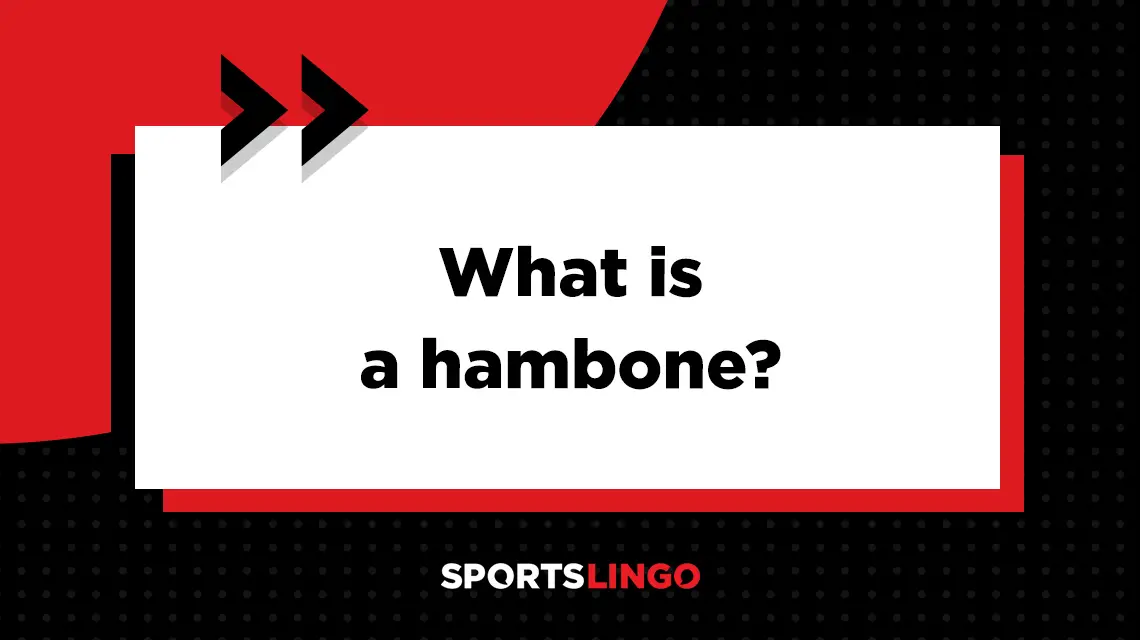
ham*bone
What is the definition of hambone in bowling?
1. Hambone is the term used in bowling to describe four strikes bowled consecutively in a single game. This name is used in the same way that turkey is used to describe three strikes bowled in a row.
Sports broadcaster Rob Stone is the originator of the term. He was known to call out “Hambone!” when a bowler rolled four strikes in a row during a game. Although some bowlers preferred the traditional term of four-bagger, hambone eventually caught on over time and is now widely used by many pro bowlers and sports organizations, including the Professional Bowlers Association (PBA).
What is a hambone in bowling terms?
A hambone occurs when a bowler gets four strikes in a row. These strikes are commonly bowled in four consecutive frames, since only one strike per frame is permitted in frames 1 through 9. For these frames, a bowler’s turn is over if they knock down all 10 pins on the first roll.
A hambone can be bowled in fewer than four frames if it involves the last frame at the end of a game. This is because the 10th and final frame can have up to three strikes. If a player knocks down all 10 pins on the first roll of the 10th frame, they get two more chances to roll the ball. So for example, a hambone could occur if a player rolls a strike in the ninth frame, followed by three more strikes in the 10th frame.
What is the opposite of hambone?
The opposite of a hambone is bowling gutter balls in four consecutive rolls. A hambone would give a player the highest possible score across four rolls, while each gutter ball is worth zero points and would therefore give the player the lowest possible score across the same number of rolls.
How many strikes is a hambone?
A hambone is four strikes. In order to qualify as a hambone, all four strikes must be bowled consecutively. If any roll that knocks down less than 10 pins occurs, the string of strikes is broken and can only be restarted once another strike is rolled by the player.
What is the most hambones in one game?
The most hambones that a player can get in one game is three. This is because the maximum number of strikes possible in one game is 12.
The following must occur for a player to roll three hambones in one game:
- First hambone: 1 strike per turn in frames 1 through 4
- Second hambone: 1 strike per turn in frames 5 through 8
- Third hambone: 1 strike in frame 9, followed by three strikes in frame 10
What is the highest score in bowling?
In ten-pin bowling, the highest bowling score for a single game is 300, which is commonly referred to as a perfect game. A player must roll 12 strikes in a row (which is equal to three consecutive hambones) in order to get a perfect game. This is accomplished by throwing one strike per frame for the first nine frames followed by three strikes in the 10th and final frame.
How do you get a hambone in bowling?
To get a hambone, you must bowl four strikes in four consecutive rolls. The best strategy to get strikes is to aim for the pocket, which is the space immediately to the right or left of the head pin (the pin positioned at the top of the pin deck and closest to the bowler).
If you’re right-handed, you should aim your bowling ball for the pocket on the right side of the head pin. Left-handers should aim for the pocket on the left side. When a player inverts this strategy (a left-handed bowler hitting the right-side pocket, for example) it’s called a Brooklyn strike.
How are hambones marked on the score sheet?
Hambones aren’t given a special mark on the bowling score sheet. Instead, they are noted any time that four strikes are marked in a row.
Each frame in bowling is represented by a box. Two smaller squares are located in the upper righthand corner of each box. The squares represent each roll a bowler gets for their turn, and the number of pins knocked down in each roll are recorded inside the squares.
With a strike, however, the score is recorded a little differently. Instead of a number, an X is placed in the first square. In the second square, a dash is entered because the player’s turn is over when they roll a strike, so they don’t get a second roll for that turn. In frame 10, a player can get up to three strikes, which would be marked with three X’s in a row.
A strike is worth 10 points (one point for each pin knocked down). As a bonus for getting a strike, the bowler also gets to add the sum of their next two rolls to the score for their strike. This is why the score for a frame with a strike will remain blank until the next two rolls have been completed.
For example, imagine that a bowler gets a strike and then their next two rolls add up to a total of seven pins knocked down. In this situation, the total score for the frame with the strike is 17 (10 + 7 = 17).
How many points is a hambone worth in bowling?
The total value of a hambone is much more than 40 points, even though it involves knocking down a total of 40 pins (10 pins per strike over four strikes). Because the next two rolls are added to the score of a frame with a strike, the consecutive strikes end up increasing the total score.
For example, the first strike in a string of four strikes is worth 30 points. This total is reached by adding 10 points for the initial 10 pins knocked down, plus 20 points for the next two strikes.
Ultimately, the total value of a hambone is affected by when it occurs in the game. If it occurs in frames 1 through 9, the score is affected by the number of pins knocked down in the two rolls immediately following the hambone. If it extends into the final frame, the total value of the hambone is lower since each strike in the 10th frame is only worth 10 points.

Dave Kallmann/USA TODAY Sports
Why is it called hambone?
Rob Stone, an ESPN sports commentator, coined the bowling term “hambone” during PBA bowling telecasts. Stone was primarily a soccer commentator prior to becoming the lead play-by-play commentator for PBA pro bowling in 2008. Being relatively new to the sport, he once asked fellow commentator and PBA Hall of Fame member Randy Pedersen on air, “If three strikes is a ‘turkey,’ why isn’t there a name for four strikes?” In the finals which aired during the following weeks, Stone started saying “Hambone!” once a bowler racked up four strikes in a row.
At the time, some bowlers bristled at the use of hambone to describe four consecutive strikes. The term “four-bagger” was already used for this achievement, and there were some bowling leagues, including the United States Bowling Congress (USBC) youth league, who already used hambone to refer to two consecutive strikes.
However, the new bowling lingo caught on and eventually became widely used by bowlers, fans, and commentators alike. The PBA has also embraced the term, and some credit increased interest in the sport with the way Stone added more enthusiasm and excitement to broadcasts with his “Hambone!” catchphrase.
Terms for strings of strikes in bowling
Each strike streak, from two in a row to 12 in a row, has a unique name in bowling lingo.
What is 2 strikes in a row called?
Most bowlers call two strikes in a row a double. Although some bowling circles refer to two consecutive strikes as a hambone, it is far more common to see the term used for four strikes in a row.
What is 3 strikes in a row called?
Three bowling strikes in a row are called a turkey. This is one of the most widely known bowling terms for a string of strikes. The origin of the term isn’t entirely clear, but it’s thought to have come from competitions held in bowling alleys during the late 17th and early 18th centuries. At the time, bowling was a popular form of entertainment in the United States. Food baskets were a common prize awarded to the top scorers, with a turkey often included among the winnings.
Because bowling three strikes in a row can provide a significant boost to a bowler’s store and increase their chances of winning, it’s thought that the ideal of “bowling a turkey” may have been coined around this time.
What is 4 strikes in a row called?
In addition to hambone, four-bagger is another term commonly used to refer to four consecutive strikes. This is part of a tradition of using bagger to refer to any string of strikes greater than three (4-bagger, 5-bagger, 6-bagger, etc.).
What is 5 strikes in a row called?
The most common term used to describe five strikes in a row is five-bagger. However, some refer to it as a Yahtzee in reference to the popular dice game in which five dice showing the same number is called a Yahtzee.
Another term for five consecutive strikes is brat, which is short for bratwurst. This is a continuation of the meat-related terms for three and four consecutive strikes (turkey and hambone, respectively).
What is 6 strikes in a row called?
Six-bagger, six pack and sixer are all bowling terms for six strikes in a row. Some bowlers call six consecutive strikes a wild turkey since it represents two turkeys (three consecutive strikes) rolled back to back.
What is 7 strikes in a row called?
The bowling terms for seven strikes in a row are seven-bagger and ham-turkey dinner. The latter term refers to the fact that a hambone (four strikes in a row) plus a turkey (three strikes in a row) is equal to seven consecutive strikes.
What is 8 strikes in a row called?
Bowling terms for eight strikes in a row include eight-bagger and octopus, a reference to the sea creature’s eight limbs.
What is 9 strikes in a row called?
Bowlers call nine consecutive strikes a golden turkey due to the fact that this feat is accomplished by getting three turkeys in a row. Another term for nine consecutive strikes is nine-bagger.
What is 10 strikes in a row called?
Ten-bagger means 10 strikes in a row in bowling lingo.
What is 11 strikes in a row called?
The bowling term for 11 consecutive strikes is 11-bagger.
What is 12 strikes in a row called?
When a bowler gets 12 strikes in a row, it’s called a perfect game. Twelve is the most possible strikes a bowler can roll in a single game (one per frame for the first nine frames, plus three strikes in frame 10).
What does front or back strike mean?
If a string of strikes begins with the first ball that a bowler rolls, it is sometimes described with the term “front (number of strikes).” For instance, a string of four strikes that begins in the first frame could be called the “front four.”
The term “back (number of strikes)” refers to a string of strikes that ends in the final frame of the game. For example, if a bowler’s last six rolls of the game are all strikes, it can be referred to as the “back six.”
Examples of how hambone is used in commentary
1. That’s four strikes in a row for Robert Smith, giving him his first hambone of the tournament.
Sport the term is used:
1. Bowling
Also known as:
1. Four-bagger